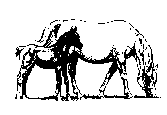Additional site navigation is at the bottom of each page.
EPM Equine Protozoal Myeloencephalitis
EPM: A New Menace
In our ongoing effort to keep our clients abreast of new developments in the medical world of the horse, we want to discuss Equine Protozoal Myeloencephalitis (EPM). Many of you have not yet heard of this disease, or if you have it has been referred to as “possum disease.” I do not think we diagnosed a single case two years ago. In fact, the first cases in the U.S. were diagnosed in 1990. We saw only a handful last year. In the last three months we have confirmed one new case each week! I think these will be only a fraction of the cases we see next year.
Before we talk about the horse that is infected, a little about the disease, about how it is spread, and why it is here would be in order. The name itself tells us a great deal about the disease. “P” is for protozoa, an organism that would be found between the bacteria and the virus if you were forced to study this type thing. It is more independent than a virus, but is less affected by antibiotics than bacteria. The “M” is for Myeloencehphalitis, referring to inflammation of the spinal cord.
The adult organism is carried by certain birds and, to a lesser extent, insects. Once within a bird, the adult will produce millions of sarcocysts (juvenile stages). These encyst within the bird’s muscles and stay. When the bird dies, the opossum shows up and has bird for dinner. These sarcocysts start reproducing within the opossum’s intestines, and produce an immature stage, the oocyte. These are passed with the stool wherever the possum goes, which is often over the grass in the field, the hay in the barn, and grain wherever it can be found. The oocytes will stay alive within the stool for over a year if not ingested. If a bird picks up grain with the infected manure on it, they become infected and reproduction starts over again. If the horse ingests any with the feed or forage the sarcocysts take a different route.
Once ingested by the horse, the sarcocysts move to the spinal cord. It may take them from days to years to reach the cord ,but they will persist until they are inside. Once there they will immediately start dividing. The effect they have on the horse is dependent on where in the spinal cord they locate.
The organism does not complete its life cycle within the horse. So the horse is not infectious to other horses on the same farm., or to birds or opossums. If two horses on the same farm become infected, it is because both of them ingested opossum manure with their feed.
The disease is found most commonly (60% of the time) in horses less than 3 years old. Nationwide it is found most commonly in thoroughbreds, and in gaited horses of all breeds. This may be because it is moving northwest from the Kentucky and other southeast states, where these breeds are very common. In our clinic we see as many Quarterhorses with the disease as other breeds. My colleagues tell me that the large thoroughbred farms in Kentucky start their weanlings on medication. They maintain them on the EPM medicine until they sell the foals as yearlings, because EPM is so common there. The disease outbreaks are following the territory of the opossum. They are not yet common in the north and west. The University of Missouri Veterinary School reports EPM is the most common neurological disease they see, and they saw more of EPM than all other neurological cases combined in 1996.
Diagnosing the disease can be challenging. It must be considered in almost any neurological and lameness cases. We have seen it in horses with sore backs, lack of coordination, drooping lips and eyes, and stumbling. More about the diagnosis and treatment next week. In the meantime, write your congressperson about starting a national opossum eradication program.
CLICK BELOW TO DISPLAY A PRINTER-FRIENDLY COPY OF THIS ARTICLE
Select "Open this file from its current location," if you just want to print it out,
it will open in a simple word processing application, select the print button.
(unless you want to save this article in your computer's memory)

 EPM_A_New_Menace.txt
EPM_A_New_Menace.txt